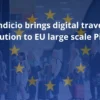Vital records — such as your birth, death, marriage, and divorce certificates — are going digital. The only question is how. In this article, we explain why verifiable credential technology offers the best solution.
By Tim Spring
As we look to modernize legacy systems and create digital equivalents of our most important and personal documents, it is important to get this transformation right. As a leading developer of verifiable data solutions using open-source decentralized identity technology, Indicio would like to offer the following recommendations for governments looking into turning vital paper records into vital digital records.
Do
Build on open-source technology
To put it simply, don’t tie yourself to proprietary technology when technology is evolving at a rapid pace. Plus, there’s the risk of not being able to interoperate with other identity and data ecosystems unless you go down the path of costly and complex direct integrations. With open source you own your solution and can develop on it as you see fit. You also benefit from the innovation generated by a vibrant open-source community. Community-developed code tends to be more resilient code.
Make use of decentralization technology
Decentralized identity technology allows people to hold their own data and share it in a way that the authenticity and integrity of the data can be verified without having to check in with or create a direct integration with the issuer of the information. This means that a vital record can be immediately trusted and easily shared across different systems. Sharing records through a peer-to-peer encrypted channel further enhances privacy and security.
Provide verification methods for partners and stakeholders
When it comes to vital records, digital copies will only be as useful in proportion to their adoption and verification. To have a successful solution businesses and organizations must be able to easily recognize and verify a vital digital record as an acceptable document.
More partners and stakeholders also bring their own points of view, priorities, and use cases; they may have ideas for adoption and use cases that you haven’t thought of yet!
Start somewhere
You need to make something. Excitement over an idea can spread easily, but progress cant happen until you have a prototype or proof of concept. Even if it’s not perfect, it drives feedback from stakeholders, customers, or partners.
Don’t
Get locked into a proprietary solution
Even if it’s a solution from a big name there’s alway the risk of loss of support or costly upgrades. Open-source code provides longevity—it’s something you can fully own, develop on as you see fit, or draw on new features being added to the codebase by other users. This is why governments are increasingly requiring open-source solutions in RFPs.
Wait for the perfect solution
Several states have already implemented virtual driver’s licenses. The technology is mature and has already been deployed by many governments. As the technology evolves incremental changes are possible to keep your solution up to date.
Build a siloed solution
Interoperability is important to creating a vital record that is widely recognized. Building and testing your solutions with other compatible solutions guarantees your records will be easily verifiable.
A key takeaway here is that this technology is not difficult to integrate into current systems. All this data is already available in government databases. The addition of verifiable credentials allows people to better manage their own documents and have an extra layer of security and verification.
The effort to move vital records from paper file cabinets to digital wallets or files is both nuanced and exciting to the team here at Indicio. If you found these tips helpful or would like to pick our team’s brain about a specific project you are working on please feel free to reach out to us here.
To learn more about Vital records you can hear about some of the efforts to implement systems at the upcoming Cardea call.






